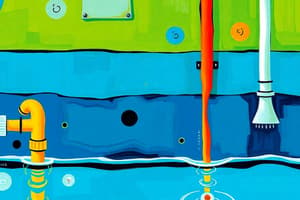Podcast
Questions and Answers
What is the purpose of a sanitary drainage system?
What is the purpose of a sanitary drainage system?
- To purify water for reuse
- To carry away effluent from plumbing fixtures (correct)
- To reduce trap water seals
- To generate excessive pneumatic pressures
Which components generally make up a sanitary drainage system?
Which components generally make up a sanitary drainage system?
- Roof drains and stormwater pipes
- Vent pipes and building sewers
- Vertical risers and horizontal drains
- Horizontal branches and vertical stacks (correct)
What should the designer consider to economically design a sanitary drainage system?
What should the designer consider to economically design a sanitary drainage system?
- Using the smallest pipes possible (correct)
- Using the largest pipes possible
- Allowing solids to accumulate in the piping
- Generating excessive pneumatic pressures
Why is it important to use the smallest pipes possible for a sanitary drainage system?
Why is it important to use the smallest pipes possible for a sanitary drainage system?
What might happen if a sanitary drainage system is not designed to carry away soiled water rapidly?
What might happen if a sanitary drainage system is not designed to carry away soiled water rapidly?
What is the main vertical pipe that carries the discharge from plumbing fixtures to the building drain?
What is the main vertical pipe that carries the discharge from plumbing fixtures to the building drain?
Which type of stack receives flow from non-sanitary plumbing fixtures and other clear water waste from equipment?
Which type of stack receives flow from non-sanitary plumbing fixtures and other clear water waste from equipment?
What permits flow from the drain to enter the stack with a component directed vertically downward?
What permits flow from the drain to enter the stack with a component directed vertically downward?
What is the ultimate vertical velocity attained by the falling sheet of water called?
What is the ultimate vertical velocity attained by the falling sheet of water called?
What is the distance the sheet must fall to attain the terminal velocity called?
What is the distance the sheet must fall to attain the terminal velocity called?
Flashcards are hidden until you start studying
Study Notes
Sanitary Drainage System Overview
- The purpose of a sanitary drainage system is to carry away soiled water and waste rapidly.
System Components
- A sanitary drainage system generally consists of various components, including pipes, drains, vents, and stacks.
Design Considerations
- To economically design a sanitary drainage system, the designer should consider factors such as minimizing pipe sizes and optimizing pipe layout.
Pipe Sizing
- Using the smallest pipes possible for a sanitary drainage system is important to:
- Reduce material costs
- Decrease excavation and installation costs
- Minimize potential blockages
Consequences of Poor Design
- If a sanitary drainage system is not designed to carry away soiled water rapidly, it can lead to:
- Backups and overflows
- Property damage
- Health hazards
Stack and Drain Components
- The main vertical pipe that carries the discharge from plumbing fixtures to the building drain is called a stack.
- A vent stack receives flow from non-sanitary plumbing fixtures and other clear water waste from equipment.
- A stack vent permits flow from the drain to enter the stack with a component directed vertically downward.
Vertical Flow and Velocity
- The ultimate vertical velocity attained by the falling sheet of water is called terminal velocity.
- The distance the sheet must fall to attain the terminal velocity is called the terminal fall.
Studying That Suits You
Use AI to generate personalized quizzes and flashcards to suit your learning preferences.




